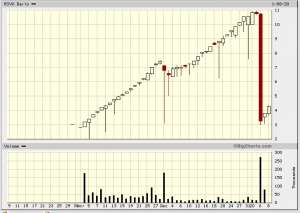Get the Pitchfork—Private Equity is Coming
Big money is finally flowing into the Canadian microcap market after a long period of depressed valuations, limited investor interest, and relatively scarce capital. However, it’s arriving in an unexpected form—private equity from the U.S. is buying Canadian microcap companies, taking them private, and removing them from the hands of retail investors.
In an ideal world, more Canadian retail investors would flood the microcap market, supporting homegrown success stories, with institutional capital following close behind. This would reward diligent investors who have patiently held their positions through the current downturn, knowing the true value of the companies they own.
Instead, we’re witnessing a troubling trend: U.S. private equity is moving in, acquiring Canadian microcaps at discounted prices just as many of these companies are hitting their inflection point. These businesses, poised for significant growth, are being taken private before their full potential can be realized. Small minority investors, who have supported these companies through challenging times, find themselves with almost no say in the outcome. As a result, they are sidelined, forced to watch as the companies they believed in are removed from public markets before they can truly benefit from the upside.
What’s Happening?
Private equity is doing what it does best: putting capital to work by identifying undervalued or underperforming companies, injecting capital, and implementing strategic operational improvements to drive growth and profitability. By leveraging industry expertise, they aim to enhance business performance and ultimately generate strong returns through a profitable exit, such as a sale or IPO.
Over the past few decades, private equity has typically incubated private companies for longer periods, using IPOs as liquidity events once the businesses have matured. This is why the current surge in private equity interest in Canada’s microcap market is notable for two reasons: it highlights the deeply discounted valuations in the sector, but it’s also alarming for minority investors. They risk having their companies taken out of public markets at precisely the moment they are poised for significant growth, effectively losing control of the upside they’ve supported.
The multi-decade decline in U.S. IPOs, as highlighted by Wilshire Indexes, reflects two key trends: the sharp drop in public offerings and, more significantly, the increasing capital raised by U.S. private equity funds. These funds are now flush with more capital than ever, creating intense competition to deploy that money amid a shrinking pool of targets. With fewer companies going public, private equity is looking for alternative opportunities, leading to a spillover of capital into Canadian microcaps, which are ripe with discounted valuations.

There are several factors likely driving this trend—from the high cost of capital in today’s interest rate environment, which stifles new business formation, to the concentration of wealth among fewer, larger firms that are absorbing smaller companies. For retail investors, the critical takeaway is that as IPOs dwindle and private equity funds amass more capital, the search for new acquisition targets intensifies. This leaves Canadian microcaps, with their deeply discounted valuations, as prime candidates for buyouts—often at the expense of minority shareholders who have little control over the outcome.
Why Canada?
American private capital swooping in to buy Canadian assets for cheap isn’t new; it’s a long-standing stereotype. But now it’s evolving. A recent Wall Street Journal article highlighted how firms like Blackrock are democratizing access to private equity, allowing individual investors to allocate as much as 10% of their portfolios to private markets. This shift puts more pressure on private equity firms to find fresh opportunities, and Canadian smallcaps are a prime target.
Impact on Canadian Smallcaps
The influx of private equity into the microcap market creates a double-edged sword for Canadian companies and investors. On the one hand, it brings much-needed capital, potentially lifting valuations across the sector. On the other hand, retail investors often see their investments bought out at a premium that seems attractive in today’s depressed market—but is far below the companies’ true long-term potential.
Atrium Research recently highlighted a wave of private equity acquisitions targeting Canadian microcaps. The common thread: these companies are undervalued, profitable, cash-flow positive, and growing. In other words, they are exactly the kinds of businesses that attract savvy retail investors—only to be taken out prematurely by private buyers. Sound familiar? These are the exact types of companies we look for.
The most recent takeovers are listed below, with the gray-shaded entries representing the most recent acquisitions as of September.

Notable Recent Takeovers
We’ve heard from several frustrated investors who have experienced this trend firsthand. One example is OneSoft Solutions (OSS.V), which was recently taken private. Despite the company’s stock price struggling over the past few years, it remained a solid business with promising growth potential. Investors had anticipated a much higher valuation, but the buyout price merely reflected the stock’s early 2024 highs, leaving many feeling shortchanged.

Another one of the most recent cases is Givex Corp (GIVX.TO), which was bought out by U.S. private equity for $200 million. These examples are part of a broader trend of private equity snapping up Canadian companies for modest premiums, leaving long-term investors thinking they received a proverbial dime, when it should have been dollars.

The Good News
The silver lining is that more money entering the microcap market will gradually lift valuations. As private equity continues to make acquisitions, stock prices in the sector will likely rise as investors realize just how undervalued many of these companies are. Additionally many of the investors are likely tp re-invest their capital back into the market, and with a diminishing supply of quality companies, we anticipate valuations will rise.
This influx of capital could also encourage more companies to go public. With fewer good microcap companies available, demand will rise, leading to higher valuations and potentially sparking a new cycle of IPOs as companies see an opportunity to tap public markets.
Interestingly, Atrium Research notes that these acquisitions haven’t touched companies with market caps under $30 million. This means that nano and microcaps could remain under the radar, offering significant upside potential for retail investors who hold on to these stocks until they reach much higher valuations.
The Bad News
While the premiums offered by private equity may seem generous—sometimes as high as 75%—they often fall short of the true value of these companies. For investors who believe that the best Canadian smallcaps are worth many multiples of their current price, these buyouts feel like a missed opportunity.
Retail investors lose out when private equity swoops in and buys their shares at a discount. They’ve held on through tough times, only to see their investments taken away just as the upside begins to materialize. In many cases, management benefits from a buyout, while minority shareholders are left with little say in the process.
The Power of Sticking Together: Voting Against Unfavorable Transactions
As retail investors, we’re not powerless in the face of private equity takeovers. One of the most effective ways to protect our investments is by standing together and voting against transactions that we believe undervalue our holdings. Collective action through “no” votes can send a clear and united message to management and private equity that we won’t accept deals that don’t reflect the long-term potential of the companies we’ve supported. In many cases, these buyouts benefit a select few while sidelining the minority investors who have held through difficult periods, only to miss out on the real upside.
By aligning our votes and remaining committed to our positions, we can influence outcomes and potentially halt transactions that strip us of future gains. Retail investors have an opportunity to reclaim some control by exercising their voting power. It may seem like a daunting task to challenge the might of institutional investors, but when we stick together and amplify our collective voice, we can resist deals that don’t serve our best interests and push for valuations that truly reflect the companies’ potential.
Where Do We Go From Here?
So, should retail investors revolt?
On one hand, the market is functioning as it always does—allocating capital to where returns are likely to be highest. But the trend is concerning for those invested in the microcap market. After propping up Canadian microcaps through tough times, retail investors now face competition from large pools of private equity that can offer attractive—yet ultimately underwhelming—premiums.
The dominance of private equity in microcap acquisitions marks a reversal of the usual script, where private money would take private companies public. Instead, we’re seeing public companies go private, potentially consolidating wealth in the hands of the few, just as firms like Blackrock promise to “democratize” investing.
This could signal a dangerous trend of shrinking opportunities for retail investors. Or, it could bring much-needed capital into the microcap market, boosting valuations, freeing up cash for new investments, and ushering in a fresh wave of public offerings.
For now, keep your pitchfork close—you may need it.



